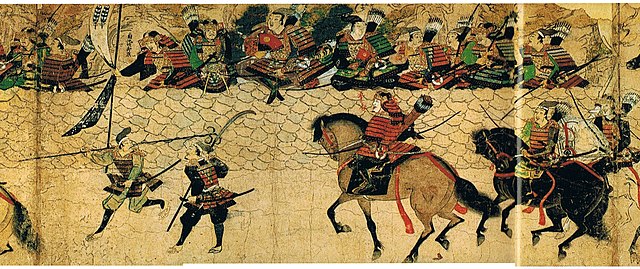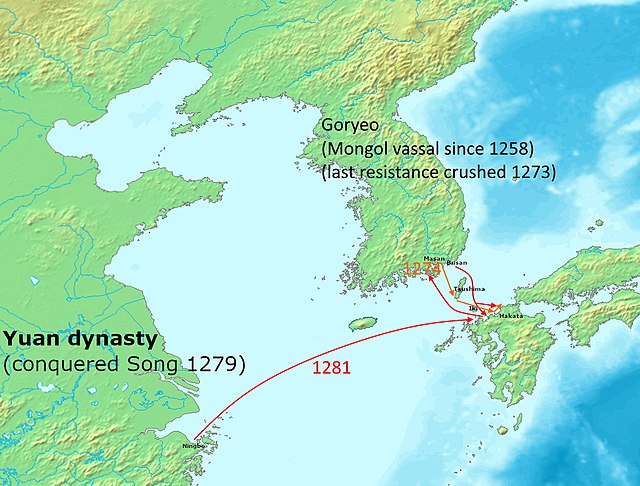The Battle of Bun'ei , or Bun'ei Campaign, also known as the First Battle of Hakata Bay, was the first attempt by the Mongol-led Yuan dynasty of China to invade Japan. After conquering the Japanese settlements on Tsushima and Iki islands, Kublai Khan's fleet moved on to Japan proper and landed at Hakata Bay, a short distance from Kyūshū's administrative capital of Dazaifu. Despite the superior weapons and tactics of the Yuan forces, those that disembarked at Hakata Bay were grossly outnumbered by the samurai force; the Japanese had been preparing, mobilizing warriors and reinforcing defenses since they heard of the defeats at Tsushima and Iki. The Japanese defenders were aided by major storms which sunk a sizable portion of the Yuan fleets. Ultimately, the invasion attempt was decisively repulsed shortly after the initial landings.
Japanese samurai defending the stone barrier at Hakata.
Kagesuke Shoni and his forces in Akasaka
Suenaga and escaping Mongolians and Koreans
Mongol invasions of Japan
Major military efforts were taken by Kublai Khan of the Yuan dynasty in 1274 and 1281 to conquer the Japanese archipelago after the submission of the Korean kingdom of Goryeo to vassaldom. Ultimately a failure, the invasion attempts are of macro-historical importance because they set a limit on Mongol expansion and rank as nation-defining events in the history of Japan. The invasions are referred to in many works of fiction and are the earliest events for which the word kamikaze is widely used, originating in reference to the two typhoons faced by the Yuan fleets.
Mongol invasions of Japan in 1274 and 1281
Letter from Kublai Khan of the "Great Mongol State" (大蒙古國) to the "King of Japan" (日本國王), written in Classical Chinese, the lingua franca in East Asia at the time, dated 8th Month, 1266. Now stored in Tōdai-ji, Nara, Japan.
Samurai Mitsui Sukenaga (right) defeating the Mongolian invasion army (left)
The Mongol fleet destroyed in a typhoon, ink and water on paper, by Kikuchi Yōsai, 1847







